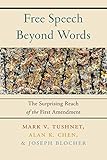Free Speech Beyond Words : The Surprising Reach of the First Amendment / Joseph Blocher, Alan K. Chen, Mark V. Tushnet.
Material type: TextPublisher: New York, NY : New York University Press, [2017]Copyright date: ©2017Description: 1 online resourceContent type:
TextPublisher: New York, NY : New York University Press, [2017]Copyright date: ©2017Description: 1 online resourceContent type: - 9781479880287
- 9781479830695
- 332.44/3 23
- JC591
- online - DeGruyter
| Item type | Current library | Call number | URL | Status | Notes | Barcode | |
|---|---|---|---|---|---|---|---|
 eBook
eBook
|
Biblioteca "Angelicum" Pont. Univ. S.Tommaso d'Aquino Nuvola online | online - DeGruyter (Browse shelf(Opens below)) | Online access | Not for loan (Accesso limitato) | Accesso per gli utenti autorizzati / Access for authorized users | (dgr)9781479830695 |
Browsing Biblioteca "Angelicum" Pont. Univ. S.Tommaso d'Aquino shelves, Shelving location: Nuvola online Close shelf browser (Hides shelf browser)

|

|

|

|

|

|

|
||
| online - DeGruyter Evaluating Police Uses of Force / | online - DeGruyter Picture Freedom : Remaking Black Visuality in the Early Nineteenth Century / | online - DeGruyter Plucked : A History of Hair Removal / | online - DeGruyter Free Speech Beyond Words : The Surprising Reach of the First Amendment / | online - DeGruyter Catholic Social Activism : Progressive Movements in the United States / | online - DeGruyter Japan : The Precarious Future / | online - DeGruyter Parkchester : A Bronx Tale of Race and Ethnicity / |
restricted access online access with authorization star
http://purl.org/coar/access_right/c_16ec
A look at First Amendment coverage of music, non-representational art, and nonsenseThe Supreme Court has unanimously held that Jackson Pollock's paintings, Arnold Schöenberg's music, and Lewis Carroll's poem "Jabberwocky" are "unquestionably shielded" by the First Amendment. Nonrepresentational art, instrumental music, and nonsense: all receive constitutional coverage under an amendment protecting "the freedom of speech," even though none involves what we typically think of as speech-the use of words to convey meaning. As a legal matter, the Court's conclusion is clearly correct, but its premises are murky, and they raise difficult questions about the possibilities and limitations of law and expression. Nonrepresentational art, instrumental music, and nonsense do not employ language in any traditional sense, and sometimes do not even involve the transmission of articulable ideas. How, then, can they be treated as "speech" for constitutional purposes? What does the difficulty of that question suggest for First Amendment law and theory? And can law resolve such inquiries without relying on aesthetics, ethics, and philosophy? Comprehensive and compelling, this book represents a sustained effort to account, constitutionally, for these modes of "speech." While it is firmly centered in debates about First Amendment issues, it addresses them in a novel way, using subject matter that is uniquely well suited to the task, and whose constitutional salience has been under-explored. Drawing on existing legal doctrine, aesthetics, and analytical philosophy, three celebrated law scholars show us how and why speech beyond words should be fundamental to our understanding of the First Amendment.
Mode of access: Internet via World Wide Web.
In English.
Description based on online resource; title from PDF title page (publisher's Web site, viewed 01. Nov 2023)


